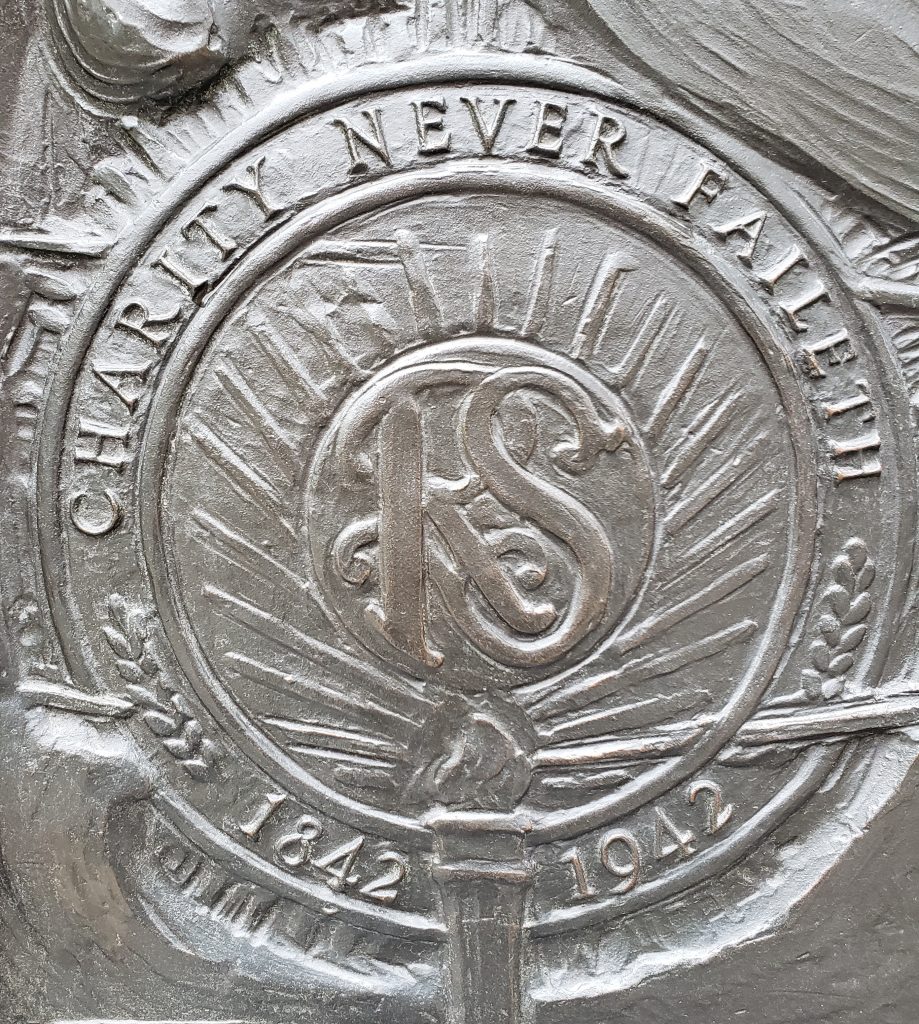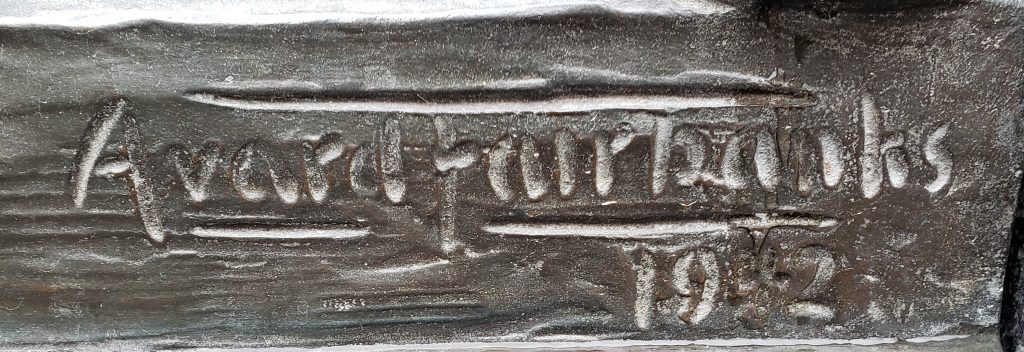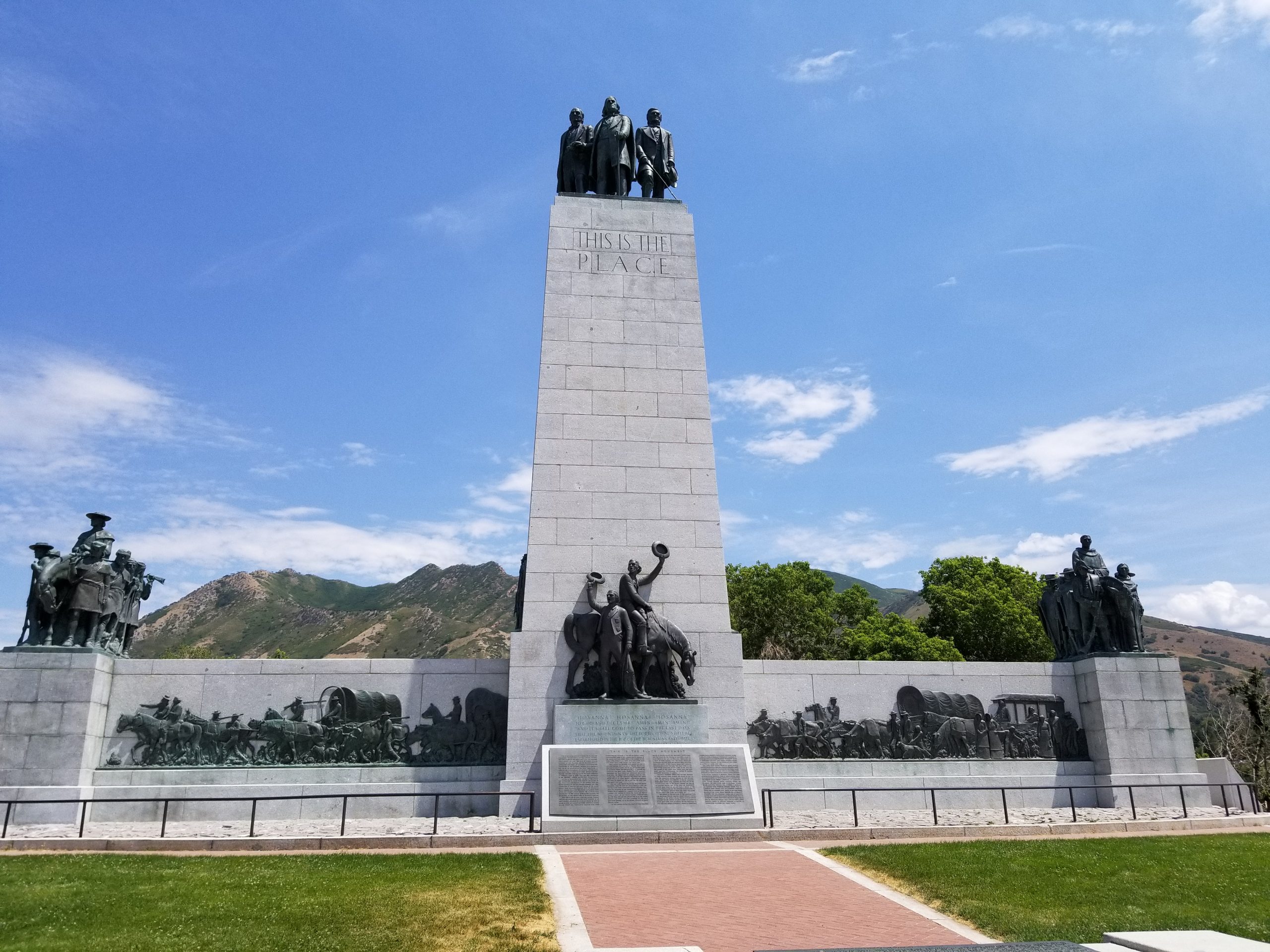Write-up by Amy Shaw
Placed by:
The Relief Society – Woman’s Benevolent Organization of the Church of Jesus Christ of Latter – Day Saints
Latitude: 40.76996655
Longitude: -111.89330947
Historical Marker Text (1) – Sign:
The Nauvoo Bell originally hung in the temple that Church members built in Nauvoo, Illinois, in the 1840’s. The Saints removed the bell in 1846 when they were forced to leave Illinois because of persecution. Following instructions from Brigham Young, the second company of pioneers carried the bell to the Salt Lake Valley. During their journey, they rang the bell to signal daybreak and departure and to warn that night sentries were on duty. The bell is now rung hourly as a symbol of religious freedom and is heard on KSL Radio.

This monument honors the Relief Society, an organization founded on 17 March 1842 for women of the Church. The bell tower was built with donations from Relief Society members to mark the organization’s centennial.
Historical Marker Text (2) – East Side: RELIEF SOCIETY CENTENNIAL MEMORIAL
Here in the shadow of the temple, on this spot hallowed by the tread of pioneer feet, the Relief Society – woman’s benevolent organization of the Church of Jesus Christ of Latter-day Saints erects this monument.
It stands as an expression of appreciation for the wondrous opportunities for soul growth that have come to womankind since the time one hundred years ago when in 1842 the Relief Society was organized in Nauvoo, Illinois, by the prophet Joseph Smith, who said :
“I now turn the key in your behalf in the name of the Lord and this society shall rejoice, and knowledge and intelligence shall flow down from this time henceforth… let kindness charity and love crown your works.”

In this tower hangs the famed Nauvoo temple bell whose lifetime spans a century of church history. A sentinel in the sacred temple at Nauvoo, the bell in vibrant tones rang out the changing moods of faithful saints as they experienced first peace and joy, and later the anguish of parting from all that they had toiled to build. Immediately following the original pioneers with Brigham Young at their head, came the second company in the great exodus to the west. Heading this veritable host of Israel, the bell played well its part in the westward trek. It awakened the herdsman at dawn, called the Saints from their wagons to kneel in morning prayer, rang again to start the day’s march, and in the solemn stretches of the night, it quieted the fears of the people as it warned stray Indians that the sentry was at his post.
It is with gratitude that this monument is dedicated to the thousands of unsung Relief Society heroines who over a period of one hundred years have stimulated intellectual development and given compassionate service without thought of honor or reward. These valiant women have nourished the hungry, clothed the needy, nursed the sick, buoyed up the discouraged and disconsolate, and tenderly prepared the dead for burial.
Relief Society General Presidents
1842 – 1942
Emma Smith Emmeline B. Wells
Eliza R. Snow Clarissa S. Williams
Zina D. H. Young Louise Y. Robinson
Bathsheba W. Smith Amy Brown Lyman
Historical Marker Text (3) – South Side:
BENEVOLENCE

Through Love Serve One Another
Historical Marker Text (4) – North Side: EDUCATION
The Glory of God is Intelligence


Historical Marker Text (5) – West Side:
PIONEERING
No Toil Nor Labor Fear
Extended Research:
In July of 1845, a letter from Brigham Young was published in the Millennial Star, asking the saints in Britain to donate money that would fund the making of a bell to be placed in the Nauvoo temple. Wilford Woodruff, who was the president of the British Mission was charged with encouraging the Saints to raise the funds and collect the money.1 The British Saints raised 535 pounds.2
There is some confusion as to whether the bell was purchased in England or America. Due to a letter to Woodruff, from Young which states, “I wrote you in my last letter that we intended to purchase the bell in this country and desired you to transmit the money collected for that purpose by the first safe opportunity,” it is believed that the bell must have been bought and constructed in America. However, there are accounts from others recalling “a large bell some of the brethren (missionaries) had sent from England by ship to New Orleans, thence by river steamer up the Mississippi River to Nauvoo, where it was hung, with some difficulty, in the steeple of the Temple.” There are no records of the bell’s purchase to back up either account.3

It is believed that the bell was completed and arrived in the city of Nauvoo in early June of 1846, where it was hung for a short time in the belfry of the Nauvoo Temple. In the time it was there, the bell was used to sound the alarm for anti-Mormon mob attacks. One such attack was the Battle of Nauvoo which took place in June 1846, when Hancock County settlers drove remaining Mormons from their homes at Nauvoo. The temple was eventually surrendered to the mobs, and the Saints were forced to flee. It is reported that as the mob marched through the temple, they rang the bell as a preacher shouted “Peace, Peace, Peace to all the inhabitants of the earth, now the Mormons are driven.” One man, John R. Young, as he and the other Saints were fleeing, stopped to write:
“The silvery notes of the temple bell
That we loved so deep and well;
And a pang of grief would swell the heart,
And the scalding tears in anguish start
As we silently gazed on our dear old homes” 4

It is here that the history of the Nauvoo Bell becomes murky. According to Edith Smith Eliot, the great-granddaughter of Wilford Woodruff, the bell was stolen from the temple and taken to a protestant church, where the Lamoreaux family stole it back for the LDS Church. The tale goes that “one stormy night the men gathered in secret and without horses pulled the wagon to the Church and lowered the Bell, pushed and pulled the wagon by hand to the edge of the Mississippi River and carefully concealed it in the water. Andrew Lamoreaux and his brother, David, were chosen to bring the Bell to Utah with their families, concealing the Bell in their wagon with their provisions.”5 This story, however, is most likely not about the Nauvoo Bell but actually about Hummer’s Bell, a bell made for a Presbyterian church under the direction of Michael Hummer in 1844. Somehow the history of these two bells have gotten mixed up.6
What is actually believed to have happened to the Nauvoo Bell is that in September, when Brigham Young heard that the Saints were forced out of their homes in Nauvoo, he wrote to the trustees of the Church property saying, “Since you will have no further use of the Temple Bell, we wish you to forward it to us by the first possible chance, we have much need of it at this place.” Reports from Joshua Hawkes tell us that he and a Latter-day Saint by the name of James Houton then took the bell across the Mississippi River, where it fell under the charge of Joseph P. Heywood. Heywood then took the bell to Winter Quarters.7

It is believed that the bell arrived in Winter Quarters in Nebraska Territory in December of 1846. Here, the bell was placed in the public square and was used to call members to worship services and other meetings.8
Then, in June of 1847, a wagon company led by Charles C. Rich transported the bell to the Salt Lake Valley.1 During the journey, it was attached to a wagon so that it could be rung to awaken the company each morning, signal morning prayer, to start each day’s march, and to warn the company of any Indian attacks.9

The company arrived in Salt Lake in September of 1847. The bell was then placed in a fort in the city for a short time until it was moved to the bowery on Temple Square. It remained there until the winter of 1849 -1850 when it cracked. This resulted in the bell being melted down and recast.10 The recast bell measures 23 1/2 inches tall, 33 inches wide at its base, and 2 1/2 inches thick.11 It was then placed in Brigham Young’s schoolhouse located just east of the Beehive house, in 1860.12 It remained there until 1902 when it was presented to the Utah State Historical Society, and placed in the LDS Church museum. It remained on display there for many years.13

In 1941, John Taylor announced that the bell would be permanently placed in a tower on the grounds of the Tabernacle before the observance of the centennial of the National Relief Society, in 1942.14 However, due to World War II breaking out, the tower’s erection was postponed to 1966. The tower was designed by Lorenzo S. Young, grandson of Brigham Young.15 It stands 35 feet high and is located between the Assembly Hall and Tabernacle on Temple Square.16 The bronze artwork at the base of the tower was done by renowned sculptor Avard T. Fairbanks.17 The first sculpture is of the monogram RS (for Relief Society) and a picture of the Nauvoo temple. The next two sides depict the twofold work of the Relief society, education, and benevolence. And the last sculpture commemorates the Church’s pioneering spirit.18

It is believed by some that the Nauvoo Bell Tower is a response to a prophecy made by Brigham Young in which he said: “Right west of the temple … we shall build a tower and put a bell on it. … This plan was shown to me in a vision when I first came onto the ground.”

Today, the Nauvoo Bell serves as an hourly time signal for KSL TV and radio. This began in 1961 with President of the LDS church, David O. McKay presiding at the ceremonies at KSL TV.19 The tolling of the bell marks the top of each hour on KSL by use of a microphone on Temple Square. There is a 7-second delay from the sounding of the bell to the listener’s ear on the radio.20
Footnotes:
[1] Ronald G. Watt, “A Tale of Two Bells: Nauvoo Bell and Hummer’s Bell,” Mormonhistoricsites.org, accessed March 17, 2019, http://mormonhistoricsites.org/wp-content/uploads/2013/05/NJ11.2_Watt.pdf. [2] Don F. Colvin, “Religious Studies Center,” 11. The Fate of the Temple | Religious Studies Center, 2002, accessed March 17, 2019, https://rsc.byu.edu/archived/nauvoo-temple-story-faith/11-fate-temple. [3] Colvin, “Religious Studies Center,” 11. [4] David R. Crockett, “The Nauvoo Temple: “A Monument of the Saints”,” http://mormonhistoricsites.org, accessed March 17, 2019, http://mormonhistoricsites.org/wp-content/uploads/2013/05/NJ11.2_Crockett.pdf. [5] “I’ve Heard There Is a Story behind the Bell on Temple Square. Can You Relay It?” Ensign, February 1981, accessed March 30, 2019, https://www.lds.org/study/ensign/1981/02/i-have-a-question/what-is-the-story-behind-the-bell-on-temple-square?lang=eng. [6] Watt, “A Tale of Two Bells.” [7] Colvin, “Religious Studies Center,” 11. [8] Watt, “A Tale of Two Bells.” [9] “I’ve Heard There Is a Story.” [10] Watt, “A Tale of Two Bells.”[11] Colvin, “Religious Studies Center,” 11.
[12] Watt, “A Tale of Two Bells.” [13] Colvin, “Religious Studies Center,” 11. [14] “Church Prizes Only Relic, Leader Asserts,” Salt Lake Telegram, 3 October 1941, page 10, Utah Digital Newspapers. [15] Connie Lamb, “Symbols of the LDS Relief Society,” Mormonhistoricsites.org, accessed March 17, 2019, http://mormonhistoricsites.org/wp-content/uploads/2013/08/Symbols-of-the-LDS-Relief-Society.pdf. [16] “Nauvoo Bell’s ‘clang’ Is Back on KSL Radio,” Deseret News, June 23, 2005, accessed March 17, 2019, https://www.deseretnews.com/article/600143553/Nauvoo-Bells-clang-is-back-on-KSL-Radio.html. [17] Athelia T. Woolley, “Art to Edify: The Work of Avard T. Fairbanks,” accessed March 17, 2019, https://www.lds.org/study/ensign/1987/09/art-to-edify-the-work-of-avard-t-fairbanks?lang=eng. [18] Lamb, “Symbols.” [19] “I’ve Heard There Is a Story.” [20] “Nauvoo Bell’s ‘clang’ Is Back.”For Further Reference:
Primary Sources:
“Church Prizes Only Relic, Leader Asserts”. Salt Lake Telegram, 3 October 1941. page 10. Utah Digital Newspapers.
Secondary Sources:
“I’ve Heard There Is a Story behind the Bell on Temple Square. Can You Relay It?” Ensign, February 1981. Accessed March 30, 2019. https://www.lds.org/study/ensign/1981/02/i-have-a-question/what-is-the-story-behind-the-bell-on-temple-square?lang=eng.
“Nauvoo Bell’s ‘clang’ Is Back on KSL Radio.” Deseret News. June 23, 2005. Accessed March 17, 2019. https://www.deseretnews.com/article/600143553/Nauvoo-Bells-clang-is-back-on-KSL-Radio.html.
